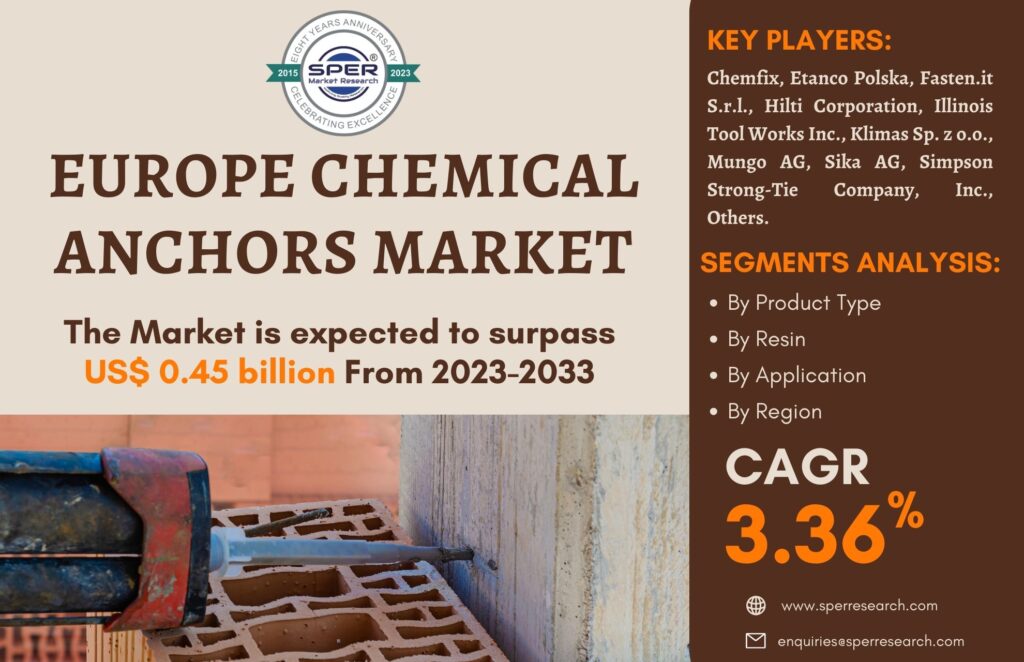Europe Chemical Anchors Market Trends 2023- Global Industry Share, Revenue, Growth Drivers, Business Challenges, Future Strategies and Competitive Analysis 2033: SPER Market Research

Strong and long-lasting bonds between structural parts and the substrate are created via chemical anchoring systems. Adhesive resin and hardening agent are their two main constituents. These ingredients come together to produce a chemical reaction that solidifies into a bond that is both trustworthy and strong. In the building, manufacturing, and maintenance sectors, chemical anchors are frequently employed to attach fixtures, machinery, and buildings.
According to SPER market research, ‘Europe Chemical Anchors Market Size– By Type, By Resin, By Application- Regional Outlook, Competitive Strategies and Segment Forecast to 2033’ state that the Europe Chemical Anchors Market is predicted to reach USD 0.45 billion by 2033 with a CAGR of 3.36%.
The European construction industry is poised for growth, driven by increased government construction spending in countries like France, Spain, the U.K., and Poland, spurred by population growth and industrial development. Notably, epoxy resin technology has evolved, enhancing functionality, shelf life, and corrosion resistance in chemical anchors. Epoxy’s pivotal role in formulations contributes to improved end-use functionality. The construction sector in major European economies, including the U.K., Italy, Germany, Spain, France, and Poland, is witnessing substantial expansion, fuelled by heightened construction, rapid infrastructure development, and a surge in renovation projects, consequently boosting the demand for chemical anchors. The market benefits from the growing preference for lightweight construction materials, rising demand for enhanced insulation, and a focus on environmentally friendly solutions. Chemical anchors find widespread applications across industrial, commercial, residential, and infrastructure sectors, addressing the need to secure structural elements to diverse materials like bricks, concrete, stone, and porous concrete.
However, chemical anchors’ primary disadvantage is that they are more susceptible than mechanical anchors to improper hole cleaning during installation. Furthermore, the increased expense of chemical anchors will likely slow down the rate of adoption in European nations. The sticky adhesive and installation equipment are included in the initial cost of chemical anchors, which makes them slightly more expensive than standard mechanical anchors. This can be challenging for small-scale projects or markets with limited funding. The emergence of substitute fastening solutions such as mechanical anchors may potentially influence the growth of the chemical anchors industry. Due to project requirements or budgetary considerations, certain apps may decide to employ other strategies.
Request For Free Sample Report @ https://www.sperresearch.com/report-store/europe-chemical-anchors-market.aspx?sample=1
Impact of COVID-19 on Europe Chemical Anchors Market
Furthermore, the COVID-19 outbreak caused a disruption in the chemical anchors industry in Europe. Buildings, civil engineering projects, and specialty construction work are all included in construction activity. On the market for chemical anchors, the Covid-19 epidemic has had both immediate and long-term impacts. Lockdowns and other limitations caused development to halt immediately, and this resulted in project delays. As infrastructure expenditures and building projects pick back up, the market has nevertheless demonstrated resiliency and recovery. Further boosting the need for trustworthy anchoring systems is the pandemic’s emphasis on the value of durability and safety in building.
Europe Chemical Anchors Market Key Players:
Geographically, Germany leads the market, driven by ongoing investments in various construction projects, with a positive outlook for the construction sector. Poland is poised for significant growth due to increasing urbanization and infrastructure developments. France expects market expansion fuelled by rising construction spending, both public and private, especially in luxury building projects. In Italy, a slow manufacturing sector limits chemical anchor application, but a growing number of domestic casinos may promote their usage. Additionally, some of the market key players are Chemfix, Etanco Polska, Fasten.it S.r.l., Hilti Corporation, Illinois Tool Works Inc., Klimas Sp. z o.o., Mungo AG, Sika AG, Simpson Strong-Tie Company, Inc., Others.
Europe Chemical Anchors Market Segmentation:
The SPER Market Research report seeks to give market dynamics, demand, and supply forecast for the years up to 2033. This report contains statistics on product type segment growth estimates and forecasts.
By Product Type: Based on the Product Type, Europe Chemical Anchors Market is segmented as; Capsule Adhesive Anchors, Injectable Adhesive Anchors.
By Resin: Based on the Resin, Europe Chemical Anchors Market is segmented as; Epoxy Acrylate Chemical Anchor, Hybrid Systems, Polyester Chemical Anchor, Pure Epoxy Chemical Anchor, Unsaturated Polyester Chemical Anchor.
By Application: Based on the Application, Europe Chemical Anchors Market is segmented as; Commercial, Industrial, Infrastructure, Residential.
By Region: This research also includes data for France, Germany, Italy, Poland, Spain, U.K., and Rest of Europe.
This study also encompasses various drivers and restraining factors of this market for the forecast period. Various growth opportunities are also discussed in the report.
For More Information, refer to below link:-
Europe Chemical Anchors Market Future Outlook
Related Reports:
Follow Us –
LinkedIn | Instagram | Facebook | Twitter
Contact Us:
Sara Lopes, Business Consultant – U.S.A.
SPER Market Research
+1-347-460-2899





